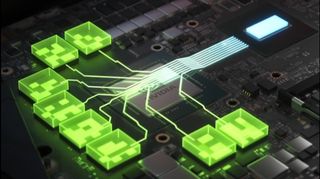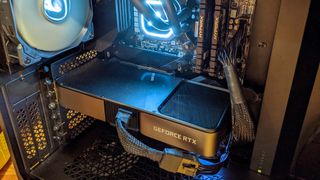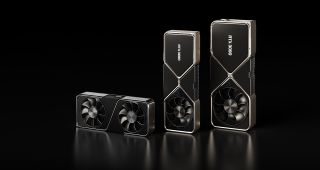Nvidia GeForce RTX 3090 vs 3080 vs 3070 vs 3060: Which GPU should you buy?
The Nvidia GeForce RTX 30-series of GPUs can power the mightiest gaming PCs on the market today. Whether you build your own system or buy one from a manufacturer, you’re going to want a gaming PC with an RTX 30-series card. (Unless you opt to go with AMD, but that’s another story.) The only trouble — aside from actually finding a card in stock somewhere — is knowing which one to choose.
At the time of writing, there are five Nvidia GeForce RTX 30-series GPUs, ranging in price from $329 to $1,499. That’s a pretty wide range. As you can imagine, these cards can power everything from a casual 1080p gaming machine to a 4K graphic design workhorse. Knowing which RTX 30-series GPU to buy can be challenging, particularly if you want it to play nicely with all the other parts in your prospective or existing machine.
At present, Tom’s Guide doesn’t have the hardware or the lab space to benchmark all of these GPUs. However, we can provide all of their relevant specs, and recommend ideal use-cases for each model. This way, if you’re willing to devote some time to tracking restocks, you’ll at least be able to focus on the graphics card that’s right for your machine.
Read on, as Tom’s Guide compares the Nvidia GeForce RTX 3060, 3060 Ti, 3070, 3080 and 3090 GPUs.
Nvidia GeForce RTX 30-series GPUs, at a glance
The easiest way to see how the Nvidia GeForce RTX 30-series cards compare to one another is simply to compare them all in a big chart. Some of this information comes directly from Nvidia; some of it is from retail sources; some of it is from our own experiences with the cards. Here’s the information that we think everyday consumers will find most useful:
| Nvidia GeForce RTX 3060 | Nvidia GeForce RTX 3060 Ti | Nvidia GeForce RTX 3070 | Nvidia GeForce RTX 3080 | Nvidia GeForce RTX 3090 | |
| Nvidia CUDA Cores | 3,584 | 4,864 | 5,888 | 8,704 | 10,496 |
| Boost Clock (GHz) | 1.78 | 1.67 | 1.73 | 1.71 | 1.70 |
| Memory Size | 12 GB | 8 GB | 8 GB | 10 GB | 24 GB |
| Memory Type | GDDR6 | GDDR6 | GDDR6 | GDDR6X | GDDR6X |
| Dimensions | 9.5 x 4.4 inches | 9.5 x 4.4 inches | 9.5 x 4.4 inches | 11.2 x 4.4 inches | 12.3 x 5.4 inches |
| Power Draw | 170W | 200W | 220W | 320W | 350W |
| Price | $330 | $400 | $500 | $700 | $1,500 |
To help you make sense of some of the more obscure terms above:
Nvidia CUDA Cores refer to parallel data processing units within a GPU. They work similarly to how a CPU works in your computer. Generally speaking, the more CUDA Cores a GPU has, the more complex data it can churn through quickly.
Boost Clock refers to the maximum speed a GPU can achieve if it has the power available and is running cool enough. There’s also a Base Clock stat, but Nvidia GPUs will draw extra resources while gaming, assuming you have a powerful system that’s not otherwise occupied. A higher Boost Clock speed generally means better performance, but it’s dependent on a lot of other factors, including your individual PC’s hardware.
Memory Type is a subtle distinction. In a nutshell, GDDR6X has more bandwidth than GDDR6 memory, and therefore (theoretically) has the capacity to run more demanding games at higher settings.
Finally, Power Draw refers to how much power the GPU can draw, by itself, while operating under a full graphical load. Nvidia also has recommendations for how much overall power you’d need for a PC with each card installed, but we didn’t include that data here, since picking a power supply is a whole separate topic.
The good news is that for all of their differences, the five Nvidia GeForce RTX 30-series GPUs compared here have a plethora of features in common. They all support 2nd-generation ray tracing; they all use the Nvidia Ampere architecture; they all make use of Nvidia DLSS (sort of an AI upscaler for games).
Nvidia FreeStyle, ShadowPlay, Highlights, G-Sync and GPU boost work on all of the 30-series cards. They’re all VR-ready, and HDMI 2.1-compatible. And, in theory, they can all support screen resolutions up to 8K. (What you’ll be able to do in 8K will no doubt vary significantly between, say, the 3060 and the 3090, but the potential is there.) Finally, they all support up to four monitors, if you’re really into productivity usage.
In other words: While the horsepower varies considerably among the Nvidia 3060, 3060 Ti, 3070, 3080 and 3090, they have a set of core capabilities in common. Which one you should get, then, depends mostly on how hard you intend to push your PC, and with which programs.
Nvidia GeForce RTX 30-series GPU recommendations
Nvidia GeForce RTX 3090
While the RTX 3090 is often easier to find than the less expensive cards, $1,500 is still a tremendous amount of money. For that price, you could very conceivably build a whole machine with one of the lower-end cards, and still have enough l
eft over for games and peripherals. Furthermore, the 3090 is arguably geared more toward productivity users, with creative suite drivers and way more memory than most games need. It’s a great card, and potentially quite future-proof. But unless you work in animation, it’s probably not worth the cost of entry.
Nvidia GeForce RTX 3080
If you can afford it, the Nvidia GeForce RTX 3080 is a pretty easy recommendation for high-end gaming systems in general. Its GDDR6X memory gives it a significant leg up over the lower-end cards, as do its nearly 9,000 CUDA cores. It’s a very large card and draws a significant amount of power, so you’ll have to be sure that your case and your power supply can support it. You’ll also need a pretty high-end processor and lot of RAM to get the most out of it. But if you have $2,000 or more to spend on a gaming PC, an RTX 3080 could be an integral part of it.
Now, the more difficult part: Comparing the 3070, the 3060 Ti and the 3060. Naturally, the 3070 is the most powerful; the 3060 is the least powerful; the 3060 Ti is somewhere in the middle. But since we haven’t had a chance to compare these cards head-to-head, it’s hard to say exactly where their strengths and weaknesses lie. We plan to test them, so stay tuned.
Nvidia GeForce RTX 3070
I can say from personal experience that I built the Tom’s Guide test rig with an Nvidia GeForce RTX 3070, and I’m extremely pleased with the way it runs games at QHD resolutions. I doubt it would be a 4K powerhouse, but I imagine it would clear 30 fps in most games easily. At $500, it’s an expensive component, but quite a bit less than either the 3080 or the 3090.
Nvidia GeForce RTX 3060 Ti
As stated above, the Nvidia GeForce RTX 3060 Ti offers 4,864 Nvidia CUDA cores and 8 GB of GDDR6 memory. This sets it apart from both the RTX 3070 (5,888 CUDA cores, 8 GB GDDR6 memory) and the RTX 3060 (3,584 CUDA cores, 12 GB GDDR6 memory). While the 3060 sports more memory, it’s still generally not as powerful as the 3060 Ti. This card seems like a reasonable choice for lower-end machines that still want decent QHD performance, but we’ll have to see how the card handles both FHD and QHD resolutions in our own tests.
Nvidia GeForce RTX 3060
As the last powerful card among the RTX 30-series, the Nvidia GeForce RTX 3060 seems like a safe bet for users who want 1080p resolution and decent frame rates. We’ll have to see how it performs with QHD screens for ourselves, but we wouldn’t count on high-end 4K performance.
The 3060 also has a slight — albeit temporary — advantage over other GPUs, in that it supports Nvidia’s resizable BAR technology. This allows for faster frame rates without much additional processing power. But since the other 30-series GPUs will gain this technology by the end of the month, the gap between the 3060 and its more expensive counterparts will widen again shortly.
For now, it might be smart to choose among the 3070, 3060 Ti and 3060 primarily on the basis of price, understanding that the more you pay, the better your performance will be.
Stay tuned, as Tom’s Guide will be testing these cards firsthand over the next few weeks. We’ll update this story with additional results then.








